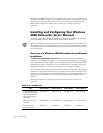
6-2 User’s Guide
• Configure the storage systems and small computer system interface (SCSI)
drives attached to your Dell PowerEdge Clusters FE100/FL100
Datacenter Server system
(see Chapter 5, “Configuring Storage Systems (Low-Level Configuration))”
NOTICE: When you install Datacenter Server, do not enable the standby
mode or hibernation mode incorporated in Windows 2000 Datacenter
Server. These modes are not supported in cluster configurations.
When you install Datacenter Server, you must configure the operating system to
enable clustering. These configuration requirements are described in the Microsoft
Windows 2000 Datacenter Server documentation. The following sections briefly dis-
cuss these configurations.
Configuring the Cluster Nodes in a
Windows 2000 Domain
Windows 2000 operates on a domain model in a server-based network. In a
Windows 2000 cluster, all of the cluster nodes must belong to a common domain—a
logical grouping of servers (such as cluster nodes) that share a common database and
security policy.
In a Windows 2000 cluster domain, all cluster nodes are assigned one of the follow-
ing tasks:
• Domain controllers—A cluster node that contains the master copy or a copy of
the domain security policy and domain database, and authenticates user logon to
the network. Multiple domain controllers provide redundancy for the network if
one of the domain controllers goes offline.
• Member servers—A cluster node that is not a domain controller and usually
provides user resources as a file, application, database, or remote access server
(RAS).
The Dell PowerEdge Cluster FE100/FL100 Datacenter Server configuration supports
the following domain assignments for each cluster node:
• All cluster nodes are member servers in a Windows 2000 domain.
• All cluster nodes are member servers in a Windows 2000 Active Directory
domain.
• All cluster nodes are domain controllers in a Windows 2000 Active Directory
domain.
• One cluster node is a domain controller in a Windows 2000 Active Directory
domain and the other cluster node is a member server in that domain.
If a cluster node is not a domain controller and is unable to contact a domain control-
ler, the cluster node will not be able to authenticate client requests. If a cluster node
is a domain controller, client access to the cluster node’s cluster resources may be
discontinued if the cluster node cannot contact the remaining domain controller(s).


















